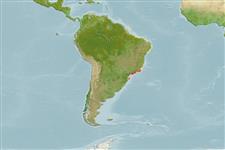>
Blenniiformes (Blennies) >
Labrisomidae (Labrisomids)
Etymology: Paraclinus: Greek, para = the side of + Greek, klinein, kline = sloping and bed, due to the four apophyses of sphenoid bone (Ref. 45335); spectator: From its habit of observing divers and its surroundings.
Environment: milieu / climate zone / depth range / distribution range
Sinh thái học
Biển Cùng sống ở rạn san hô; Mức độ sâu 1 - 7 m (Ref. 43114). Tropical
Southwest Atlantic: Brazil.
Bộ gần gũi / Khối lượng (Trọng lượng) / Age
Maturity: Lm ? range ? - ? cm
Max length : 5.2 cm SL con đực/không giới tính; (Ref. 43114)
Các tia vây lưng cứng (tổng cộng) : 27 - 29; Tia cứng vây hậu môn: 2; Tia mềm vây hậu môn: 18 - 20; Động vật có xương sống: 34. Body elongated, mean body depth 21.7% SL in adult males. Wide predorsal area, mean 22.6% SL in adult males. First 2 dorsal fin spines much longer than the rest; distance between 3rd and 4th spine greater than orbit diameter; last dorsal fin element segmented. Opercular spine flattened and triangular (Ref. 43114).
Prefers shallow rocky reefs. Smallest ripe female at 3.7 cm SL (Ref. 43114).
Life cycle and mating behavior
Chín muồi sinh dục | Sự tái sinh sản | Đẻ trứng | Các trứng | Sự sinh sản | Ấu trùng
Guimarães, R.Z.P. and A.C.L.H. de Bacellar, 2002. Review of the Brazilian species of Paraclinus (Teleostei: Labrisomidae), with descriptions of two new species and revalidation of Paraclinus rubicundus (Starks). Copeia 2002(2):419-427. (Ref. 43114)
IUCN Red List Status (Ref. 130435: Version 2024-2)
Threat to humans
Harmless
Human uses
Các công cụ
Special reports
Download XML
Các nguồn internet
Estimates based on models
Preferred temperature (Ref.
123201): 22.5 - 27.7, mean 26.7 °C (based on 94 cells).
Phylogenetic diversity index (Ref.
82804): PD
50 = 0.5000 [Uniqueness, from 0.5 = low to 2.0 = high].
Bayesian length-weight: a=0.00933 (0.00410 - 0.02122), b=3.10 (2.91 - 3.29), in cm total length, based on LWR estimates for this (Sub)family-body shape (Ref.
93245).
Mức dinh dưỡng (Ref.
69278): 3.5 ±0.4 se; based on size and trophs of closest relatives
Fishing Vulnerability (Ref.
59153): Low vulnerability (10 of 100).
